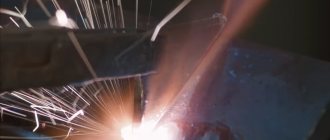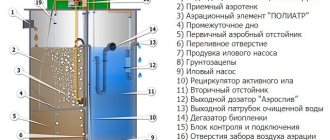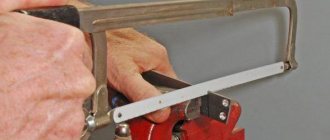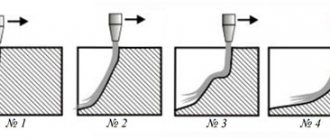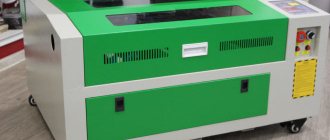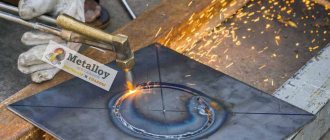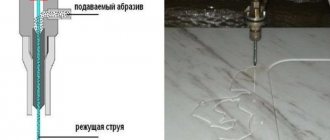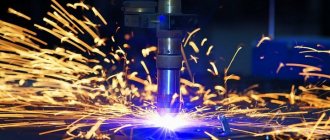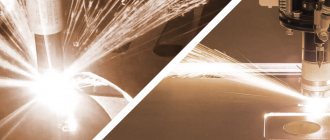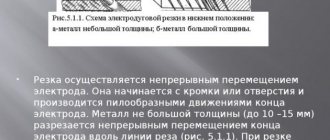Equipment that allows cutting sheet metal is required at any machine-building and metalworking enterprise. Very often, the technical capabilities of the most common types of such equipment are not enough to ensure high quality cuts.
Fluid cutting process
The essence of technology
Waterjet cutting of metal is not an innovative technology; it began to be used back in the 1960s. The American aircraft manufacturing company was the first to use machines to perform such cutting. It was the management of this company that made an official statement about this method, describing its advantages and recommending its use for cutting metal and other materials with high hardness. From that moment on, abrasive cutting of metal using water began to be actively used by enterprises and gained increasing popularity.
The essence of this technology is that water, which contains abrasive substances, is supplied to the cutting zone under high pressure. Any waterjet cutting installation works according to the following scheme.
- Water and abrasive material, which is mainly used as fine sand, are supplied from a special container to the mixer of the apparatus.
- After mixing, the water and abrasive enter the nozzle of the installation.
- A thin jet of waterjet mixture is formed in the nozzle, which is supplied under high pressure to the cutting zone.
Operating principle of hydrojet cutting
Technology implemented according to a similar scheme allows not only to perform cutting quickly and with high quality, but also to significantly save on consumables, the most expensive of which is ordinary sand. It should be noted that in terms of speed, abrasive cutting using water is comparable to plasma technology, and in terms of the quality of the resulting cut, it is comparable to laser technology.
Profile
Waterjet cutting of aluminum is one of the new metalworking technologies, but despite this, we have been able to accumulate significant, practical experience in this area, which few have achieved so far. Concluding an agreement to order cutting services means turning to competent specialists who have perfectly mastered high-precision equipment. We work not only with enterprises in Moscow and the Moscow region, but all other Russian regions can become our partners. We work equally conscientiously with organizations of any size and with private clients. Aluminum products are manufactured to order from us only from materials owned by , with further delivery directly to the customer’s warehouse.
Detailed information about the cost of our services can be obtained through the “Calculation Request” form or by phone +7 (495) 601-94-03 +7 (495) 601-92-59.
Areas of application
This technology has serious differences from all other methods of sheet metal separation. When using this method, the surface of the metal being processed does not experience pressure or other types of mechanical impact. Thanks to this, there is no friction in the cutting zone; therefore, heating of the tool and the surface of the part is eliminated, which has a positive effect on the quality of processing and significantly expands the scope of application of this technology.
Most often, abrasive cutting with water is used to separate sheet metal, but recently this method is increasingly used for processing other materials, which include:
- natural stones (granite, marble, etc.);
- ceramic tiles, sheet glass;
- carbon and stainless steel, titanium and other metals;
- reinforced concrete structures;
- various polymeric materials and rubber.
The use of waterjet cutting technology allows us to minimize the consumption of materials, which is its significant advantage. In addition, cutting using abrasive and water is the only possible way to separate metal in enterprises with a high fire and explosion hazard.
Waterjet cutting equipment
In fact, waterjet cutting machines use the ability of water to destroy various materials, which was noticed in ancient times. In order for such destruction to be more accurate, faster and more effective, it is necessary to increase the pressure with which water and abrasive act on the material, as well as to give the resulting jet the required direction. In modern machines for waterjet cutting, such problems are solved using the following elements and methods.
Hydrojet cutting allows you to cut materials of considerable thickness.
High-pressure pump
The pump in such devices accumulates liquid with abrasive and delivers this mixture to the surface of the workpiece. The performance of such machines and the thickness of the part they can cut depend on the power of the pump used.
Power regulator
Waterjet machines with such a regulator can cut using working mixtures of various compositions supplied under controlled pressure, which makes it possible to process materials of different thicknesses and structures with their help. Thus, for cutting harder materials, three-component waterjet mixtures are used, and for more viscous materials, those consisting of two components are used.
Changing the device nozzle
This technique involves selecting a nozzle of a certain design for materials of different thickness, composition and density.
Using faucets
It is this element, which is equipped with every modern waterjet machine, that is responsible for the quality and uniform composition of the working mixture and, accordingly, for the accuracy and speed of cutting, as well as for the device’s ability to process parts of large thickness.
Automation of the cutting process
When cutting metal, due to the inertia of the working fluid jet, a taper of the edge is necessarily formed, which is directly proportional to the speed of the processing process. To minimize this undesirable effect, modern waterjet machines use automatic systems that, depending on the density of the material being processed, adjust the nozzle angle.
Preparing water before using it for cutting
The quality of water used can have a major impact on cutting results and speed. That is why all modern machines use systems for preliminary purification of water from foreign impurities.
In addition to the main systems and components, waterjet cutting machines can be equipped with additional equipment that significantly expands their functionality (we are talking, in particular, about performing shaped cuts).
Modern equipment that cuts materials using a waterjet method allows you to:
- perform precise and high-quality cutting at various angles;
- cut even the most complex parts without human intervention - using software control;
- work with metal parts even of significant thickness (steel - up to 20 mm, titanium - up to 17 mm, high-strength alloys - up to 12 mm, copper and its alloys - up to 5 mm);
- obtain shaped cuts, which is very important in the production of decorative products;
- cut pipes (this is possible on certain models of waterjet machines).
Pipe hydrojet cutting machine
Hydraulic Process Capabilities
One of the main advantages of the waterjet cutting method is the absence of heating and surface chipping , which are inherent in traditional cutting of objects.
Thanks to the improvement of machines and modern technologies, it was possible to expand their scope of use and functionality:
- Possibility to make non-standard cutting of material. At the same time, changing the cutting angle does not affect the quality of cutting. The precision of cutting metal at an angle makes it possible to use finished workpieces without further processing.
- Machines for cutting metal with a narrowly directed jet can be used in rolled metal. So the maximum metal thickness when cutting is 200 mm for medium-carbon steel , 120 mm for high-strength alloys.
- There are machines that can operate without human intervention in a completely autonomous mode. In this case, it is necessary that a certain program be installed that regulates the operation of the machine. Using software control, even very complex parts can be cut.
- waterjet cutting of pipes is widespread . With the help of special machines it is possible to obtain a perfectly even cut circle.
- Art - precise figure cutting makes it possible to use machines during the manufacture of decorative elements, decorations, etc. The accuracy of the figures and the quality of the cut depends largely not on the experience of the worker, but on the quality of the software and equipment used. Where it is required that deviations be no more than 0.5%, CNC machines are used.
Numerically controlled waterjet cutting machines
A waterjet cutting machine equipped with computer numerical control (CNC) allows you to effectively solve cutting tasks of varying degrees of complexity. The high precision with which such a machine performs cutting allows us to produce even the most complex parts and significantly minimize material consumption. The technological process of cutting using this device is as follows.
- For each part, special software is installed on the machine, which controls all cutting parameters: the composition of the working mixture, its pressure, etc.
- A computer-controlled waterjet cutting machine provides constant control of the quality of the cut and adjusts operating modes if necessary. It is precisely these options of such equipment that ensure that no additional processing of finished products, including grinding, is required after it.
- CNC machines can drill holes, as well as perform a whole list of specific operations.
Waterjet cutting machine - OMAX 60120
Consumables and self-construction of the machine
In order for a waterjet machine to function fully, it is only necessary to timely replace abrasive materials and worn-out elements, which lose their service life over time. The abrasive consumption rate depends on the thickness of the material being cut: it also happens that the machine consumes about 300 g of sand microparticles per minute.
When processing metal of maximum thickness, the consumption will be even higher, about 500-600 g per minute. Parts that often require replacement include various seals and high-pressure pump elements. The latter often fail because the machine always operates at extremely high pressure, which puts stress on the parts.
In terms of building such a machine yourself, there is one problem that is almost impossible to solve - the low quality of independently manufactured parts. The fact is that building a waterjet machine requires a lot of unique parts and pieces that will have to be ordered from a turner and somehow created with your own hands. As a rule, the service life of such parts will not exceed a few days, given the pressure that they have to deal with.
Full-fledged CNC waterjet cutting machine
As a result, you will have to buy original spare parts and assembled units, while other parts will remain homemade or taken from analogues. In terms of spending money, you will spend almost the same amount as a new full-fledged waterjet machine would cost, plus you will also spend a lot of effort.
A new industrial installation for waterjet cutting costs from 3 million rubles, and a used one can be purchased much cheaper.
Performing waterjet cutting manually
Manual machines for waterjet cutting differ from automated ones in that all processing parameters in them are set, controlled and adjusted by the operator. Despite some operating inconveniences, compared to CNC equipment, such machines have a number of advantages.
- To operate such machines, which are easy to operate and have a minimum of functionality, no specialized education is required.
- The functionality possessed by manual waterjet cutting machines allows us to produce high-quality and accurate parts of simple geometric shapes.
- A manual waterjet cutting machine has an affordable price (on average 1.5 times cheaper than CNC machines).
Meanwhile, for cutting parts of complex geometric shapes and requiring particularly high precision of the resulting dimensions, it is necessary to use CNC machines.
Cutting complex shapes
Necessary materials
When waterjet cutting, two main materials are consumed, the replenishment of which must be constantly monitored:
- fine-grained abrasive material, which is most often used as garnet sand, which is characterized by particularly high hardness (the size of grains of such sand should not exceed 600 microns);
- water that has been pre-treated to remove foreign impurities.
Naturally, these are not the only materials required for cutting using water and abrasive. Any waterjet machine requires power supply, compressed air supply and replacement of worn elements, which, in particular, include:
- elements of the system responsible for supplying the abrasive mixture: nozzle, supply tubes, etc. (if a worn nozzle is not replaced in a timely manner, the hole in it can significantly increase in diameter, which will lead to a decrease in the dimensional accuracy of the cut being formed).
- sealing elements of the pumping station, which are responsible for maintaining the required pressure of the working mixture.
It should be borne in mind that the use of low-quality consumables, in particular abrasive sand, leads not only to a decrease in the quality of finished products, but also to accelerated wear of cutting equipment.
Basic design of machines
Considering the fact that waterjet machines are universal in use, they have a very specific device that allows them to cut not only metals.
Water jet cutting of stone
The technology is based on supplying water under high pressure through a nozzle to the workpiece at a certain angle. The liquid contains an abrasive material, which is an auxiliary component of cutting. Sand, crushed to microparticles, is most often used. Before serving, water and grains of sand are mixed in a special preliminary tank. The thoroughly mixed mixture is fed to the nozzle of the machine.
Water cutter for metal
Depending on the specified program, the generated jet is supplied to the workpiece. The nozzle nozzle is placed on a movable head, which can rotate and tilt in any order. The cutting speed with water can only be compared with a plasma cutter, but the accuracy and quality are comparable only with long-term laser cutting.
Advantages and disadvantages of cutting using abrasive and water
You can even evaluate the efficiency, productivity and accuracy of waterjet cutting from a video of the process. Meanwhile, there are not only visually assessed advantages of this technology, which include:
- exclusion of heating of the workpiece (hence the impossibility of its deformation and, accordingly, high cutting accuracy);
- wide functionality of the equipment, with which you can solve problems of even the highest complexity;
- no need for additional work to refine the resulting products;
- the versatility that any waterjet cutting machine has (it can be used to cut rubber, plastic, stone or metal, and drill holes in various materials);
- high speed, accuracy and cost-effectiveness of the process;
- exceptional safety of the process, including its explosion and fire safety;
- the ability to cut parts of large thickness, including tubular sections.
Hydrojet cutting of marble
No matter how effective and impressive the waterjet cutting process is (see video at the end of the article), this technology also has disadvantages. In particular, these include the following.
- When cutting, a taper is formed on the edge of the cut piece. This disadvantage is especially noticeable when cutting parts of large thickness. To prevent the appearance of this defect, it is necessary to use special automated devices that correct the nozzle angle during processing.
- Waterjet machines process both thick-walled and thin-walled parts at the same speed, which somewhat reduces the profitability of using this technology. To increase profitability, thin parts are cut several pieces at a time, putting them in a pack.
The use of waterjet cutting is especially advisable in situations where it is necessary to cut complex parts with particularly high precision, while spending a minimum amount of time.
Services of our waterjet cutting workshop in Moscow
Our company is now ready to offer you metal water cutting in Moscow, the price of which will suit the customer with any budget.
To the question “how much does waterjet cutting cost?” we will give you a clear and concise answer, and when concluding the contract, the prices will be exactly the same, and will not increase “magically”. Offering waterjet cutting in Moscow at a price worthy of your order, we guarantee:
- complete preservation of the metal structure, absence of defects and deformations;
- high-quality cut, in no way inferior to the cut after laser processing;
- accuracy and high speed of project execution.
Our water cutting machine in Moscow will help you process even such “inconvenient” materials as copper and brass. It is easy to perform waterjet cutting of aluminum using the workshop equipment; you will also like the price for this service.
